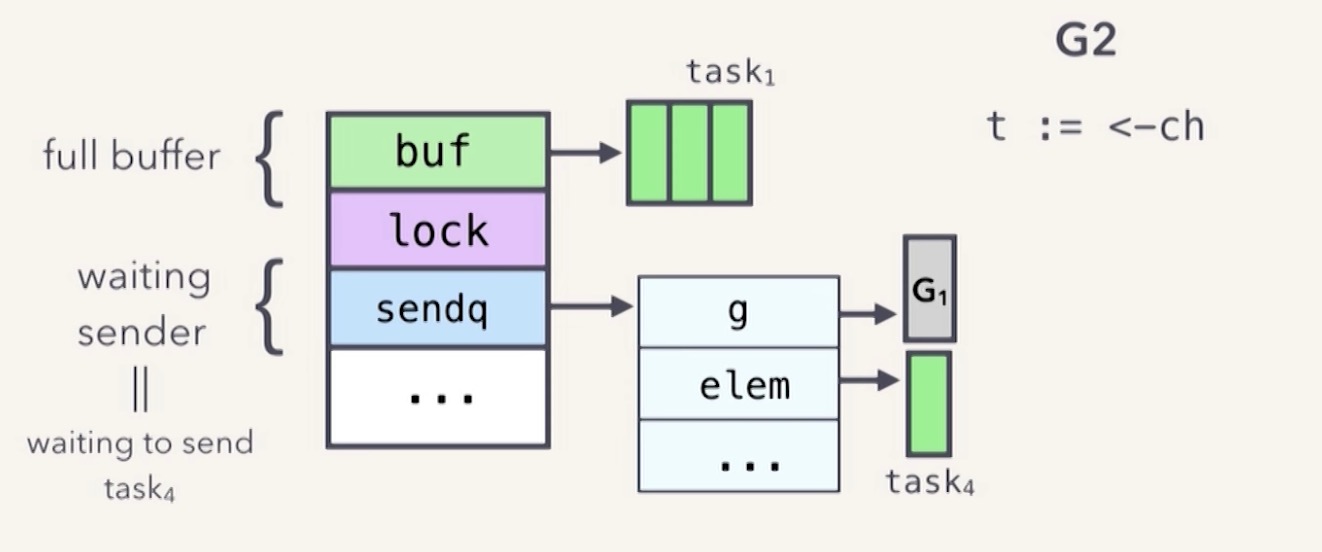Golang并发(2) - channel与context的用法和实现
除了goroutine之外,channel 是 golang 中最核心的 feature 之一,因此理解 Channel 的原理对于学习和使用 golang 也很重要。
golang社区有一句流行语:不要通过共享内存来通信,要通过通信来共享内存。实际上背后的理论基础就是CSP模型。channel就是对此的实现。
channel 提供了一种通信机制,通过它,一个 goroutine 可以向另一 goroutine 发送消息。channel 本身还需关联了一个类型,也就是 channel 可以发送数据的类型。例如: 发送 int 类型消息的 channel 写作 chan int 。
用法
channel有自己的语法糖,下面是最简单的一个代码段:
func sender(a chan int) {
for i := 0; i < 10; i++ {
a <- i
}
}
func receiver(a chan int) {
for {
r := <-a
fmt.Println("received...", r)
}
}
func main() {
ch := make(chan int)
go sender(ch)
go receiver(ch)
var block string
fmt.Scan(&block)
}
output:
received... 0
received... 1
received... 2
received... 3
received... 4
received... 5
received... 6
received... 7
received... 8
received... 9
channel数据结构
要理解channel,需要理解其实对channel的操作的语法,只是一个语法糖。而底层支持的还是很容易理解的数据结构+算法。
我们可以看到对同一个channel的操作存在一定的同步和互斥。可以类比一下java是怎么实现线程同步的。AQS是java并发工具里的同步器,它里面的数据结构其实就三个部件组成:
- 一个int标记位,标记当前锁是不是被持有。
- 一个FIFO的队列,里面排队的是所有等待这个锁的线程,全部是阻塞态。
- 保存一个指针,记录当前获得锁的线程。
channel做的事情不是同步,而是在goroutine之间传递数据,所以也会有一个数据的FIFO的队列。另外,对channel的操作也可能阻塞和唤起goroutine。所以也有类似于java里面的AQS的同步器。channel的数据结构如下:
type hchan struct {
qcount uint // total data in the queue
dataqsiz uint // size of the circular queue
buf unsafe.Pointer // points to an array of dataqsiz elements
elemsize uint16
closed uint32
elemtype *_type // element type
sendx uint // send index
recvx uint // receive index
recvq waitq // list of recv waiters
sendq waitq // list of send waiters
// lock protects all fields in hchan, as well as several
// fields in sudogs blocked on this channel.
//
// Do not change another G's status while holding this lock
// (in particular, do not ready a G), as this can deadlock
// with stack shrinking.
lock mutex
}
构成channel由几个部件组成:
- buf,保存channel的元素的一个数组。
- recvq,receiver的队列。
- sendq,sender的队列。
- lock,一个互斥器,对channel的访问需要互斥。
理解了这个数据结构之后,我们可以理解,当向一个channel执行send操作(<-)的时候,底层的数据结构会发生什么:
- 当前goroutine会尝试获得锁
- 将要传输的数据在内存中 copy一份,然后塞入buf数组中
- 释放锁
执行recv操作时,就是一个相反的过程,在获得锁后,将buf数组里面的内容copy一份,然后当前goroutine的指针指向这个copy出来的对象,并在buf数组里移除掉这个数据。
所以,当一个goroutine通过channel获取到另一个goroutine的数据,其实在内存中经过最多两次的copy,在整个过程中并没有共享内存。这样是为了避免各种并发修改同一个内存的问题。
当然,channel的作用并不仅限于数据传输,它的最大的威力在于,我们在使用channel来转移一份数据的使用权,而相关的goroutine的执行和阻塞,由底层实现。当向一个已经满了的channel执行send操作时,这个操作会阻塞当前的goroutine:
ch := make(chan int, 2)
ch <- 1
ch <- 2
ch <- 3 // block...
底层如何实现阻塞,后面又是怎么实现唤起?答案是和AQS很类似的机制:
当hchan的数据满了后(c.qcount == c.dataqsiz),再收到send操作,会将这个goroutine连同它要发送的内存一起封装起来,保存到一个队列里(sendq),然后在执行挂起。

挂起是请求scheduler实现的,可以抽象的理解为:将当前的g的状态置为Waiting,然后调度的时候scheduler就会将这个g和M解开关联,然后将这个g加入到其中一个p的队列中。
所以,当一个channel满了的时候,可以理解为这样:

此时,当有另一个goroutine过来对这个已经满了的channel执行recv操作,会做几件事:
- 从buf里出队一个ele,并copy出来给这个goroutine。
- 从sendq里,找到第一个阻塞的sudog(hchan内部对协程的封装)并出队。
- 唤醒这个协程,并将它的elem入队到buf队列里。
context
context包是goroutine之间互相管理的工具。golang是面向分布式、rpc server的编程语言。一个web server的典型场景是节点接收到上游的请求request,然后处理过程中,需要创建一些额外的goroutine,并行请求下游数据(通常是阻塞操作)。这时候,如果一个request被cancel或者time out,那么它派生的goroutines也应该快速失败掉,返回err并释放资源,context就是为了处理这种场景而产生的工具。
The sole purpose of the context package is to carry out the cancellation signal across goroutines no matter how they were spawned, context got them covered.
context的接口:
type Context interface {
// Done returns a channel that is closed when this Context is canceled
// or times out.
Done() <-chan struct{}
// Err indicates why this context was canceled, after the Done channel
// is closed.
Err() error
// Deadline returns the time when this Context will be canceled, if any.
Deadline() (deadline time.Time, ok bool)
// Value returns the value associated with key or nil if none.
Value(key interface{}) interface{}
}
Deadline返回绑定当前context的任务被取消的截止时间;如果没有设定期限,将返回ok == false。Done当绑定当前context的任务被取消时,将返回一个关闭的channel;如果当前context不会被取消,将返回nil。Err如果Done返回的channel没有关闭,将返回nil;如果Done返回的channel已经关闭,将返回非空的值表示任务结束的原因。如果是context被取消,Err将返回Canceled;如果是context超时,Err将返回DeadlineExceeded。Value返回context存储的键值对中当前key对应的值,如果没有对应的key,则返回nil。
我们来看一个典型的应用:
func main() {
ctx, cancel := context.WithTimeout(context.Background(), 1*time.Second)
defer cancel()
result := make(chan int, 0)
asyncDoStuffWithTimeout(ctx, result)
fmt.Printf("restult get: %v", <-result)
}
func asyncDoStuffWithTimeout(ctx context.Context, result chan int) {
go func() {
select {
case <-ctx.Done():
fmt.Printf("ctx is done, %v", ctx.Err())
result <- 0
return
case <-time.After(2 * time.Second):
fmt.Println("set result")
result <- 10
}
}()
}
实例中我们go了一个协程,执行一个,它会通过select case语句感知ctx是否已经关闭,如果是已经关闭,则会直接return。
重构并发
以几个例子展示怎么使用go里面的channel通道重构我们的并发编程模型。
ping pong
这个是Advanced Go Concurrency Patterns上的一个例子,两个线程通过chan交换一个struct的使用权
type Ball struct {
hits int
}
func main() {
ball := Ball{}
table := make(chan Ball)
go play("ping", table)
go play("pong", table)
table <- ball
time.Sleep(2 * time.Second)
}
func play(name string, table chan Ball) {
for {
ball := <-table
ball.hits++
fmt.Printf("%v: hit %v\n", name, ball.hits)
time.Sleep(300 * time.Millisecond)
table <- ball
}
}
并发度控制
一般而言不需要管理和控制goroutine的并发度。但如果某些goroutine做的事情对下游有依赖,且对下游的资源消耗较大,为了避免把下游瞬间打挂,还是需要控制goroutine执行的最大并行数。
在java里最简单的方法就是使用线程池,只要设置core和max的线程数,控制了实际执行的最大线程数,再多的任务提交过来也会在队列里等待,在go里面,我们没必要直接做goroutine的线程池,而是使用channel简单实现一个concurreny limiter作为限流器。
type RateLimiter struct {
tickets chan int
}
func GetLimiter(limit int) *rateLimiter {
if limit <= 0 {
limit = 10
}
tickets := make(chan int, limit)
for i := 1; i <= limit; i++ {
tickets <- i
}
return &RateLimiter{tickets: tickets}
}
func (r *RateLimiter) Exec(f func()) {
ticket := <-r.tickets
go func() {
defer func() {
r.tickets <- ticket
}()
f()
}()
}
这里相当于把channel当成一个synchronizer来使用,<-r.tickets 有可能阻塞线程。这里需要注意的是,当限流器没容量(ticket全部占用),那么Exec方法会阻塞在原地(当前线程)。
pub sub using channel
使用go channel实现pub sub pattern
//Message struct
type Message struct {
Topic string
Value interface{}
}
//Channel struct
type Channel struct {
ch chan Message
}
//Mq struct
type Mq struct {
topics map[string]*Channel
}
// var sessions map[string][]Session
//New func
func New() *Mq {
return &Mq{
topics: map[string]*Channel{},
}
}
//Subscribe method
func (s *Mq) Subscribe(topic string, handler func(m *Message), concurrency int) error {
if concurrency <= 0 {
return errors.New("concurrency less than 0")
}
// generate topic if not exist
if _, exist := s.topics[topic]; exist {
return errors.New(("Subscribe exist, topic:" + topic))
}
s.topics[topic] = &Channel{
ch: make(chan Message),
}
for concurrency >= 0 {
go func() {
for {
c := <-s.topics[topic].ch
handler(&c)
}
}()
concurrency = concurrency - 1
}
return nil
}
//Publish method
func (s *Mq) Publish(msg Message) error {
if _, ok := s.topics[msg.Topic]; !ok {
return errors.New("Topic has been closed")
}
s.topics[msg.Topic].ch <- msg
return nil
}
这里每个topic使用一个channel来实现publisher和subsriber的通信,可以看到每个subsriber都是一个goroutine,会for循环监听这个topic下的channel,当有channel ready的时候,唤醒这个goroutine。在publish的时候,如果所有subsriber都正忙,会阻塞线程。
用法如下:
func main() {
mq := New()
mq.Subscribe("topic1", func(m *Message) {
time.Sleep(1 * time.Second) // 模拟处理耗时
fmt.Printf("get msg: topic: %v message: %v \n", m.Topic, m.Value.(string))
}, 100)
go func() {
ticker := time.NewTicker(10 * time.Millisecond)
start := time.Now()
for {
select {
case <-ticker.C:
mq.Publish(Message{
Topic: "topic1",
Value: fmt.Sprintf("message: %v time pass...", time.Since(start)),
})
}
}
}()
time.Sleep(20 * time.Second)
}
ref
- https://www.youtube.com/watch?v=KBZlN0izeiY&t=66s
- https://zhuanlan.zhihu.com/p/110085652
- https://blog.golang.org/io2013-talk-concurrency
- https://studygolang.com/articles/23247?fr=sidebar
- https://blog.golang.org/context
- https://medium.com/rungo/understanding-the-context-package-b2e407a9cdae
- https://www.youtube.com/watch?v=QDDwwePbDtw&t=515s
